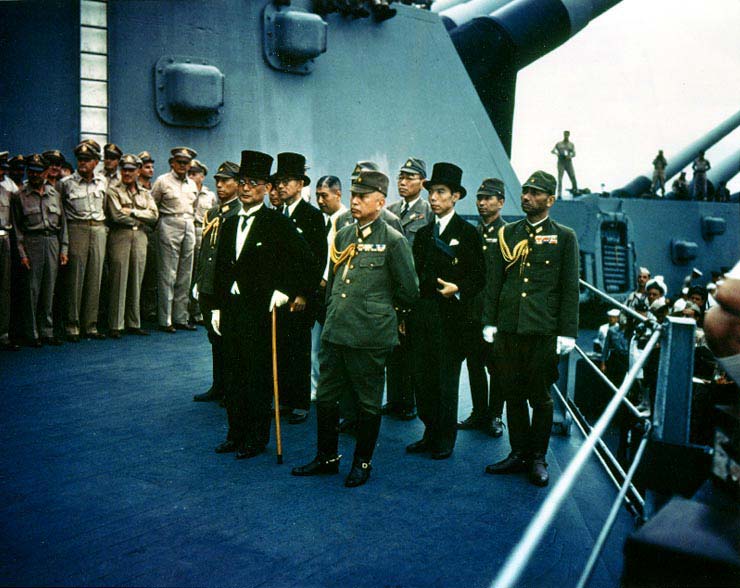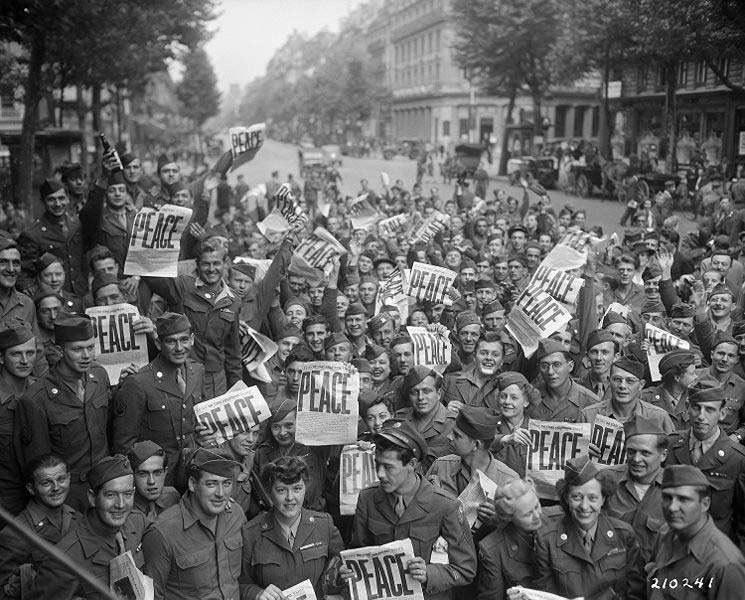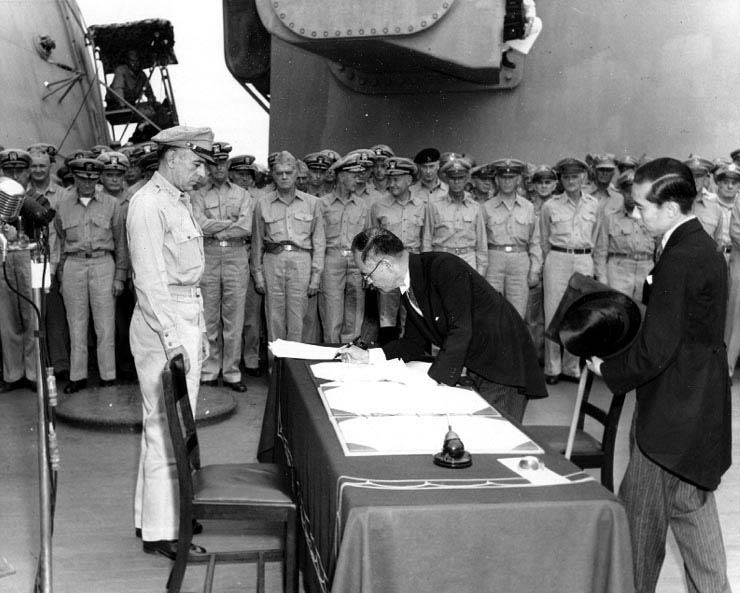 Although the nation had lost a large stronghold well before the day, the formal surrender of Japan did not take place until September 2, 1945 on the USS Missouri in Tokyo Bay. By the summer of 1945, it was clear to see that the defeat of the Japanese forces had been well underway.
Although the nation had lost a large stronghold well before the day, the formal surrender of Japan did not take place until September 2, 1945 on the USS Missouri in Tokyo Bay. By the summer of 1945, it was clear to see that the defeat of the Japanese forces had been well underway.
The navy and air force were completely destroyed, the blockade of Japanese cities and the bombings which were taking place left the nation without hope of coming back from the destruction that had taken place. Okinawa was captured by the U.S. at the end of June that year, from which the allies were able to launch more attacks on Japanese cities.
First Atomic Bomb
The invasion of Japan was the largest seaborne invasion ever, and was approximately 10 times larger than that in Normandy, in the amount of allies’ casualties. On July 16, the U.S. had a new option available to them, as the country secretly detonated the world’s first atomic bomb; 10 days after this, the allies issued the Potsdam resolution, which called for the formal surrender by all Japanese forces and military personnel. If the failure of this surrender took place, the bombing would surely wipe out the entire Japanese population and islands.
A few days later, on the 28th of July, the Japanese prime minister responded to this threat, and claimed that Japan was paying attention to the ultimatum that had been set forth by the allies. Since the surrender of Japan did not take place, President Truman ordered for the attack to go as planned. On August 6, the B- 29 Bomber dropped the atom bomb over Hiroshima, killing 80,000 people and injuring thousands more.
Potsdam Declaration
 After the bombing took place, a large majority of the supreme war council for Japanese forces, favored the Potsdam Declaration and wanted to surrender, but the majority of the council resisted for a complete surrender, which is what the U.S. and the allies wanted from Japan forces.
After the bombing took place, a large majority of the supreme war council for Japanese forces, favored the Potsdam Declaration and wanted to surrender, but the majority of the council resisted for a complete surrender, which is what the U.S. and the allies wanted from Japan forces.
On August 8, USSR also declared war on the Japanese forces, which made their already bleak situation something that was to become more of a concern to the struggling nation and its armed forces. Manchuria was attacked the next day by Soviet forces, and a second U.S. atomic bomb was dropped over Nagasaki. Although it did not cause as much devastation, it did cause tens of thousands of deaths and injuries to the Japanese.
Supreme War Council
After these attacks, on the morning of August 9, Emperor Hirohito convened with the war council, and after several debates, he backed up a proposal that was written by Prime Minister Suzuki, which was that Japan would accept the Potsdam Declaration. The council agreed with the set forth surrender, and on August 10, the declaration and the surrender of Japan, was sent over to the United States.
 On August 12 the U.S. responded, and after a few more days of debate, the Japanese Emperor stated that peace with amicable resolution and surrender was more important than the complete destruction of Japan and its people. An order by the Emperor was set that the Japanese government was to write a formal surrender document, accepting the terms of the Potsdam Declaration that was set forth by the U.S. initially.
On August 12 the U.S. responded, and after a few more days of debate, the Japanese Emperor stated that peace with amicable resolution and surrender was more important than the complete destruction of Japan and its people. An order by the Emperor was set that the Japanese government was to write a formal surrender document, accepting the terms of the Potsdam Declaration that was set forth by the U.S. initially.
Military Coup
On August 15, a military coup was attempted which was led by Major Hatanaka, where the imperials seized control of the imperial palace, and burned the prime minister’s home. The coup was immediately brought down, only a few hours after it was initiated by the military leader.
Emperor Hirohito went on the national radio at noon, to formally announce to the Japanese public that the surrender of Japan had been formalized. Once this was done, the United States immediately accepted the surrender, and this portion of the war, and destruction, had come to an end.
Formal Surrender
 President Truman had appointed MacArthur to head the Allied occupation of the Japanese forces, as the supreme commander of the allied powers. The site that was chosen by President Truman as the official site for the surrender of Japan was the USS Missouri, which was a battleship that had seen several hours of military battle; the ship was also named after the President’s home state, marking a second factor to the choice destination for the surrender to take place on.
President Truman had appointed MacArthur to head the Allied occupation of the Japanese forces, as the supreme commander of the allied powers. The site that was chosen by President Truman as the official site for the surrender of Japan was the USS Missouri, which was a battleship that had seen several hours of military battle; the ship was also named after the President’s home state, marking a second factor to the choice destination for the surrender to take place on.
MacArthur was set to reside over the surrender and the ceremonies. The official surrender of Japan did not take place until September 2, 1945, in order to allow all of the major allied power forces and officials to arrive on time, and to be a part of the surrender ceremonies.
Signing
On the morning of September 2, the flags of the U.S., U.K., China, and Soviet were placed above the USS Missouri, in order to show the major allied powers. At 9 a.m., Foreign Minister Mamoru Shigemitsu signed the surrender of Japan documents on behalf of the Japanese government, military forces, and people. General Umezu signed that the Japanese armed forces would no longer form any attacks against the Allied powers, as agreed upon in the Potsdam Declaration.
Commander MacArthur then signed the document for the United Nations. Following this, the U.K., U.S., China, Soviet, USSR, Australia, Canada, New Zealand, and the Netherlands also signed the document, which made official the surrender and ended the war with Japan. It was a rather short event. All allied powers were present along with the Japanese representatives. It was an important event, marking the end of war with Japan and the end of World War II.
As with any other document ending war, the Japanese initially resisted, but devastation, loss of lives, and loss of military power forced the Japanese surrender. It was a few months after the initial proposal was set forth by the U.S. and other major allied powers. September 2, marked the end of a major conflict, and power shifted to the Allied powers.